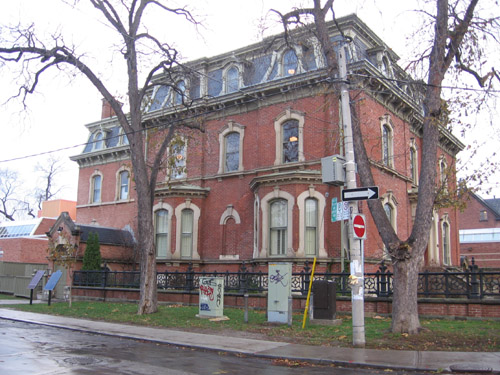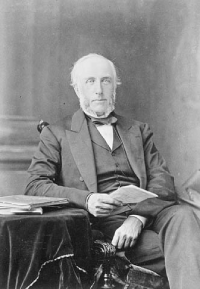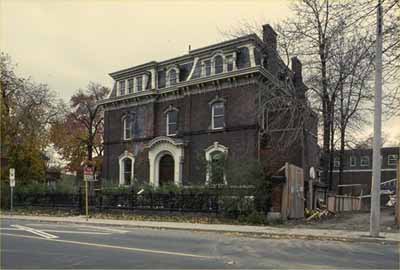George Brown House National Historic Site

© Parks Canada
George Brown House was designated as a national historic site in 1976.
Commemorative plaque: 50 Baldwin Street, Toronto, OntarioFootnote 1
George Brown House
Originally named Lambton Lodge, this elegant house was built from 1874 to 1876 for George Brown, eminent journalist, politician, and Father of Confederation. Designed in the Second Empire style so much in vogue in Canada in the 1870s, the substantial and distinguished residence reflected Brown’s prominence as a respected public figure. During his time here, Brown served as a member of the Senate and continued to be an influential voice in political affairs. Tragically, following a gunshot wound inflicted by a dismissed Globe employee, he died here in 1880 at the age of 61.
George Brown House

© Hunter & Co. / Library and Archives Canada | C-009553
This was the home of George Brown (1818-1880), eminent journalist, politician, Father of Confederation and anti-slavery activist. Located at the corner of Beverley and Baldwin Streets in Toronto, the house was originally known as Lambton Lodge and occupied by Brown, his wife and three children. Built between 1874 and 1876, with a mansard roof and Italianate details reflecting the Second Empire style popular in the post-Confederation period. This substantial and distinguished residence proclaimed Brown’s status as a successful businessman. In 1976, a century after its construction, it was designated a National Historic Site of Canada for its association with Brown.
Brown was a publisher and influential journalist, who founded the Toronto newspaper the Globe in 1844. He became a prominent member of the Reform and Liberal parties, playing an important role in the years leading up to Confederation. After 1867, he continued to be active in both provincial and in federal politics. In 1873, he received an appointment to the Senate where he served until his death in 1880. He refused both the lieutenant governorship of Ontario (1875) and a knighthood (1879), preferring to retain an independent voice in public affairs as George Brown of the Globe.
Under the leadership of George Brown, the Toronto Globe served as a prominent platform for the expression of abolitionist sentiments in Canada. Brown was a vocal opponent of slavery and a founding member of the Anti-Slavery Society of Canada (1851), effectively organizing diverse Canadian abolition efforts during this time. The society raised funds to support the activities of its members, including those in the Underground Railroad, who guided escaped slaves to freedom. It helped former slaves to establish new lives in Canada and assisted their integration into Canadian society. Brown was personally involved in helping former slaves while he lived in Lambton Lodge and, in 1998, the Historic Sites and Monuments Board of Canada acknowledged it as the Toronto site most intimately associated with the Abolitionist Movement and the Underground Railroad in Canada.
Backgrounder last update: 2016-08-10
Description of historic place

© Parks Canada
George Brown House National Historic Site of Canada is a three-storey Victorian residence located at the corner of Beverley and Baldwin streets in the heart of downtown Toronto. The property includes a red brick mansard-roofed house with carved stone trim and a elegant cast iron garden railings, built for George Brown, a Father of Confederation. The house, where George Brown spent the end of is life, now houses a museum, a meeting space and offices. The designation refers to the house on its lot.
Heritage value
George Brown House was designated a national historic site of Canada in 1976 because:
- it was the home of George Brown, a Father of Confederation;
- and it is arguably the site most intimately associated with the Abolitionist movement and Underground Railroad History in Toronto.
The heritage value of George Brown House National Historic Site of Canada lies in its association with George Brown and through him with the achievement of Canadian Confederation as well as with the Abolitionist Movement and the Underground Railroad. The historical associations are carried by the house itself in both its location and physical properties.
This house was built for George Brown 1875-1877 and occupied by his family from 1877-1886. Brown lived here in retirement until his death in 1881. At the time he lived here, Brown was owner and editor of The Globe newspaper, a Senator and a Father of Confederation. Brown and his family also had played a central role in the Abolitionist movement whose Canadian activity centered in Toronto. Brown himself was personally involved in the lives of many Underground Railroad refugees. The house has been restored by the Ontario Heritage Foundation and is open for public visitation.
Source: Historic Sites and Monuments Board of Canada, Minutes, 1976.
The National Program of Historical Commemoration relies on the participation of Canadians in the identification of places, events and persons of national historic significance. Any member of the public can nominate a topic for consideration by the Historic Sites and Monuments Board of Canada.
- Date modified :